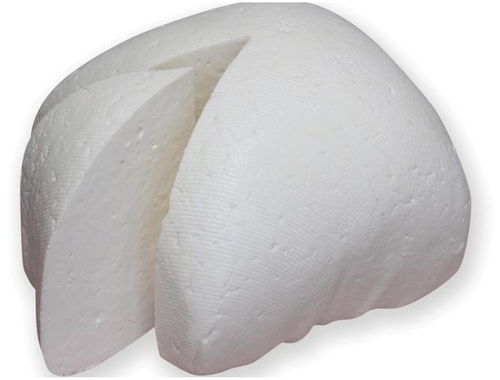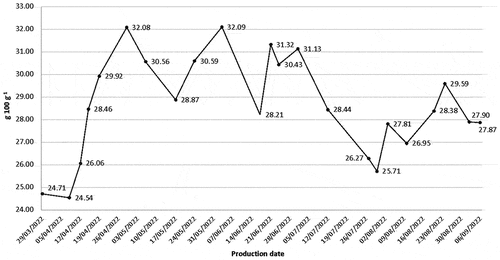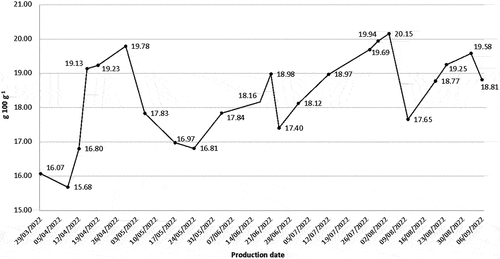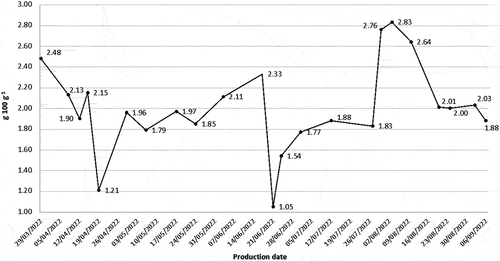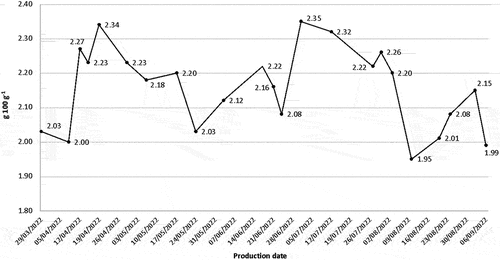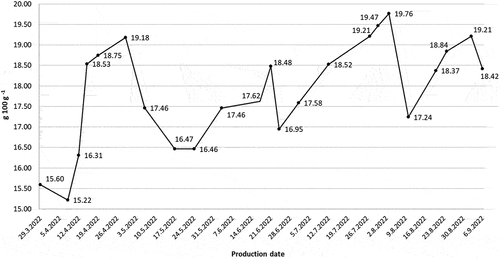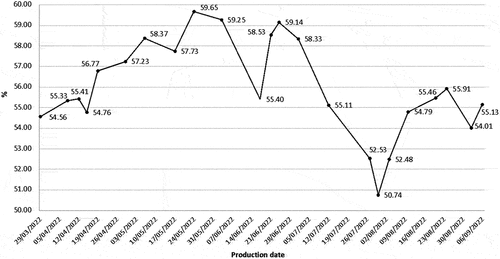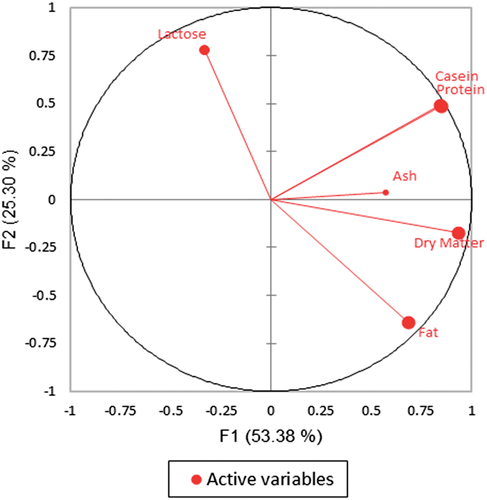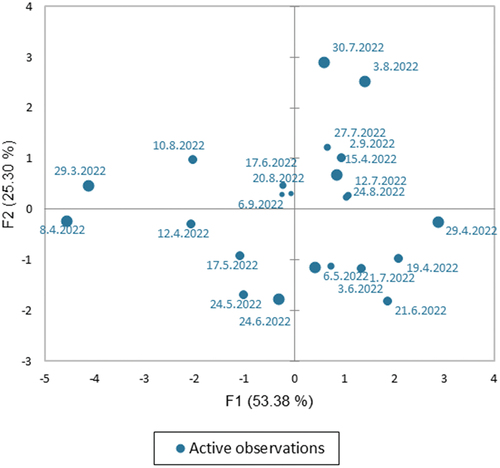Abstract
Native sheep breeds provide milk, the raw material rich in nutrients for traditional cheese products, in selected cases labelled with the logo of the Traditional Specialty of the European Union. The study aimed to find out whether seasonal or other factors may significantly affect the composition of traditional Ewe’s lump cheese (“Ovčí hrudkový syr”) manufactured on a farm in the western region of Slovakia. For this purpose, 46 samples of fresh Ewe’s lump cheeses across the season of production undergo analysis following ISO standards focused on determining total fat, dry matter, protein, total casein, and ash. The mean values of the content of individual analytes were as follows: fat 28.60 g 100 g−1, dry matter 51.10%, protein 18.33 g 100 g−1, lactose 2.00 g 100 g−1, ash 2.16 g 100 g−1, casein 17.88 g 100 g−1. Based on statistical evaluation of the results, six significant differences have been found, namely: fat (.01), protein (.005), lactose (.005), dry matter (.05), ash (.001) and casein (.001). Considering all the evaluated aspects of such a product, the Traditional Ewe’s lump cheese presents relatively stable products in the content matter over the season.
Keywords:
1. Introduction
Using local animal genetic resources has become a world-wide priority for sustainable agriculture. Indigenous domestic animal populations are affected by indiscriminate crossings with foreign specialized breeds (Ermias & Rege, Citation2003). Due to natural selection and evolution resulted in a loss of the variability of these local genotypes, which are distinguished by their adaptation to challenging edaphoclimatic conditions, disease resistance, and consumption of natural pastures (Zaitoun et al., Citation2005). For Slovakia, typical sheep breeds well adapted to local conditions are Tsigai, Lacaune and Valachian breeds, with balanced milking traits and composition over the season. Amigo et al. investigated the impact of genetic variation on the proteins found in sheep milk and their connections to the technological characteristics of milk (Amigo et al., Citation2000). Housing conditions, region characteristics, interactions between seasonal changes, nutrition and physiological changes, the season of lambing and the stage of lactation considerably influence milk composition and, consequently, the cheese quality (Albenzio & Santillo, Citation2011; Coulon et al., Citation2004; Micari et al., Citation2007; Sanz Sampelayo et al., Citation2007; Zaitoun et al., Citation2005; Zervas & Tsiplakou, Citation2011).
Furthermore, mentioned factors directly influence the milk quality parameters, such as casein, milk fats, ash content, etc. (Sevi et al., Citation2004), which are key factors for the cheesemaking process and output quality. Since milk production increases significantly in the spring and declines from July to November, most Ewe milk cheeses in Southern Europe are produced in the spring (Medina & Nuñez, Citation2017). Most ewe milk is used to make cheese, which stands out among dairy products because of its unique flavour, aroma, and taste. Many kinds of cheese from ewe milk produced in European countries are protected by the European Union legislation and are marked with specific PDO, PGI and TSG marks. Moreover, many traditional kinds of cheese are manufactured from ewe milk. They may sometimes be mixed with cow milk (DOOR, Citation2014) to create desired sensory characteristics of the product, accepted by consumers. Generally, regional food made according to traditional recipes is popular among consumers in food production, as they are perceived to be tasty, healthy, and/or high-quality products (Knysz et al., Citation2018). The most recognizable traditional Ewe’s cheese products available on the Slovak market are “Ovčí hrudkový syr salašnícky” (fresh Ewe’s lump cheese), “Bryndza” (made from fermented and matured Ewe’s lump cheese), “Oštiepok” (smoked semi-hard Ewe’s cheese), and steamed cheeses like “Parenica” and “Korbáčik”. From the chemical point of view, in comparison to other animal species, ewe’s milk is characterized by: 11.5% non-fatty solids, 9% ash, 7.1% fat, 5.7% protein and 4.8% lactose (Treacher & Caja, Citation2022). The lactose content is relatively stable and shows only slight variation, as its synthesis determines the rate of daily milk production. Protein and fat contents are high at the beginning of lactation, gradually decrease during the lactation peak and subsequently increase as the milk yield decline (Bencini & Pulina, Citation1997; Bencini et al., Citation2003; Treacher & Caja, Citation2022). Casein presents the major protein in the global aspect, determined in several isoforms, all found in complexes with phosphorus and calcium (Treacher & Caja, Citation2022). The milk transformation into cheese involves several fermentative processes where milk macronutrients are used as a substrate. Based on the outputs from several studies, it is known that cheese composition depends on cheese type (Lucas et al., Citation2005). The cheese production processes and degree of acidification during fermentation influence the content of minerals and vitamins. Thus, detailed chemical characteristics of various cheese types may be helpful in the authentication and traceability of milk and cheese products (Prache et al., Citation2005).
Such cheeses are traditionally produced from fresh milk and are typical for their sensory traits and physical and chemical properties: spherical shape, dry matter creates more than 40% of cheese weight, where fat content presents at least 50% of dry matter, cheese acidity ranges in between 5.2 and 4.9 (Publication of an application for registration pursuant to Article 8(2) of Council Regulation (EC) No). Typically, matured Ewe’s lump cheese is crushed, milled, and salted, in most cases, used as a primary input raw material for traditional Slovak Bryndza cheese production (MARD, Citation2016).
A major object of the presented study was Ewe’s lump cheese “Ovčí hrudkový syr”. The scientific hypothesis and the primary goal of our study were to confirm or exclude whether the season of production may significantly affect the composition of Ewe’s lump cheese.
2. Materials and methods
2.1. Design of the experiment
Ewe’s Lump cheese production was realized by a small food business operator Agrosúča a.s., Dolná Súča, Slovakia, European Union (Coordinates: 48°58′N 17°59′E, Elevation: 429–751 m) from 29 March 2022 to 6 September 2022.
2.1.1. Animals and farming conditions
• A single flock of animals consisting of 30% Tsigai, 70% Lacaune breeds was housed. Since April, they were housed in a free-range barn with straw bedding, consequently outside stabled.
2.1.2. Lambing
• In Slovakia, the typical season of lambing for ewes is during the springtime, specifically from late winter to early spring. In this experiment, the lambing was between the months of February and April. The lactation period for ewes lasts around 90–120 days.
2.1.3. Feeding conditions
• Ewe’s: during the winter, stall-fed composed of haylage, silage and concentrate feeds including grains, protein sources, minerals, and vitamins. Common types of forage used for haylage and silage production included grasses (ryegrass or fescue) and legumes (clover or alfalfa).
• Since April, Ewe’s have been grazed in the pasture. Common grass species in the pasture included ryegrass, timothy grass, and meadow fescue, legume species like white clover or red clover.
• In autumn, the feed was the same as during the winter.
• The described nutrition management is typical for sheep farming in Slovakia.
2.1.4. Milking conditions
• Milk was collected from a single flock and collected in a round parlour, chilled to 14°C and then transported to a farm dairy.
2.2. Cheese production process
Ewe’s lump cheese was made from raw milk within 2 h after milking. The milk was tempered to 30°C–32°C. Consequently, 40 ml of microbial rennet per 100 l of milk was added under continuous stirring. The microbial rennet was based on the salt-stabilized fungus Rhizomucor miehei. Curds were stirred and cut with a curd harp to obtain the desired dimension of 0.5–1 cm of grains. Previously boiled drinking water cooled to 65°C was added directly to curds to improve whey release from the curd grains. The curds were stirred well and left to rest. Subsequently, settled curds were compressed by hand (approx. 10 minutes) to form a lump with a cheesecloth. A formed lump was left to drain for about 2 h, hanging on a hook. After draining, the cheese was transferred to a warm storage area (ripening room), where the fermentation process started (the temperature must not fall below 18–22°C). Cheese lump wrapped in the cheesecloth hung on a hook and later placed on a shelf designed to allow the whey to drain off. The described fermentation process takes 2–3 days ().
2.3. Cheese sampling
Cheese sampling was performed according to ISO 707 (ISO 707:Citation2008:2008, 2008), and samples were vacuum-packed and frozen at −18°C. Every week, two cheese samples were gathered from the production batch, and once a month, they were transported to the laboratory. To fulfill the study purpose, 46 cheese samples were analyzed. The initial sample was obtained in late March to align with the lambing season observed in this study. The final samples were collected at the beginning of September, coinciding with the completion of cheese production.
2.4. Methods for Cheese composition determination
2.4.1. Fat content
According to the method defined by ISO 1735:2004 - intended for cheese/processed cheese products by using the Gravimetric method (the reference method) (ISO Citation1735:2004 IDF 5:2004, Citation2004).
2.4.2. Protein content
According to the method defined by ISO 8968–1:2014 - intended for milk/milk products using the Kjeldahl principle and crude protein calculation according to nitrogen content presence (ISO Citation8968–1:2014 IDF 20–1:2014, Citation2014).
2.4.3. Lactose content
According to the method defined by ISO 22,662:2007 intended for milk/milk products, the use of high-performance liquid chromatography (the reference method) (ISO 22662,Citation2007IDF 198:2007, 2007).
2.4.4. Dry matter content
According to the method defined by ISO 5534:2004 intended for cheese/processed cheese, by determining total solids content (the reference method) (ISO Citation5534:2004 IDF 4:2004, Citation2004).
2.4.5. Ash content
According to the method defined by AOAC. The initial sample was weight (A). The sample was dried in the oven at 102 ± 2°C for at least 2 h or until a constant weight was obtained. Sample was cool to room temperature and weight (B). The dried sample was transferred to weighed, preheated porcelain crucible and incinerated in a muffle furnace at 500°C for 5 h. Cooled to room temperature in a desiccator, crucible, and ash weight (C). Ash content (%) = (C - B)/A x 100 (Official Methods of Analysis of AOAC INTERNATIONAL, Citation2023).
2.4.6. Casein content
Total protein content (TP%) was analyzed according to (ISO Citation8968–1:2014 IDF 20–1:2014, Citation2014), and non-casein nitrogen (NCN%) content was determined using the Kjeldahl method (ISO 17997–1:Citation2004 IDF 29–1:2004, Citation2004). Casein content was calculated as the difference between TP and NCN content.
2.5. Statistical analysis
The Shapiro–Wilk test was used to verify data distribution, and one-way ANOVA was used to analyze the variance with Tukey post hoc test. Individual samples taken for composition analysis were classified into groups according to the month in which they were taken (March–September). The created seven groups were used as factors for the ANOVA test. We considered the results to be significant at p < .05, .01 and .005. Principal component analysis (PCA) did the visualization of cheese composition data. XLSTAT v. 2021.4.1 (Addinsoft, France) software was used to statistically treat the obtained results.
3. Results and discussion
Results of Ewe’s lump cheese composition are presented in Table . Individual mean values were calculated from two results of two duplicate cheese samples from the same production batch (n = 46). The fat content was 28.60 g 100 g−1, protein content 18.33 g 100 g−1, and dry matter 51.10 g 100 g−1.
Table 1. Ewe’s lump composition
Results obtained in the present experiment over the season of production showed a significant (.01) seasonal effect on the concentration of individual milk components evaluated in treated cheese samples. Based on such records, the stability of the product, including variations in composition during the milking season, may be helpful in a more detailed definition of such a kind of product. Moreover, this may contribute to establishing an image of the standard properties for authentication needs. Concerning the fat content, the lowest values, 24.71 and 24.54 g 100 g−1, were found at the beginning of the milking season—the end of March, followed by a rapid increase in fat concentration with a peak value of 32.08 g 100 g−1 in the second half of April (Figure ). Further, a relatively stable trend had been drawn by small decreases. It increased 28.21–32.09 g 100 g−1 until the beginning of July, followed by a sharp decline recorded continuously until the beginning of August 25.71 g 100 g−1. After this falling trend, fat concentration returned to rising, with a peak value of 29.59 g 100 g−1 detected at the end of August. The last values at the end of the milking/cheese production season from fresh milk—the beginning of September are presented by the following concentrations: 27.9 and 27.87 g 100 g−1.
The protein changed significantly (.005) during the production season. A similar trend as fat was observed at the beginning of the milking season/production of cheese from fresh milk, with initial values of 16.07 and 15.68 g 100 g−1 and a peak value of 19.78 g 100 g−1 detected at the beginning of May (Figure ). Further, the decrease was determined by 16.81 g 100 g−1, the bottom value was stopped at the end of the same month. Moreover, the protein content increased until the end of the second half of June, 18.98 g 100 g−1, followed by a slight drop determined by the value 17.40 g 100 g−1 found at the end of June. A relatively stable rise in protein concentration was observed until the beginning of August, characterized by the highest measured value, 20.15 g 100 g−1. Since then sharp decrease of 17.65 g 100 g−1 followed by a protein concentration increase within the same month was found. The last recorded value was presented by the concentration 18.81 g 100 g−1 at the beginning of September.
A diametrically different trend was found in the case of lactose evaluation compared to the above-described fat and protein. The initial value of 2.48 g 100 g−1 recorded at the beginning of the production season was followed by a decreasing trend in lactose concentration presented by the value of 1.21 g 100 g−1 recorded in the second half of April (Figure ). Since then relatively sharp lactose increase was stopped at the beginning of May, 1.96 g 100 g−1, followed by a slight increase trend with small lactose concentration drops until it reached the value of 2.33 g 100 g−1 at the half of July. The next period was determined by a sharp concentration decrease presented by 1.05 g 100 g−1 - the bottom value for lactose recorded at the same month and followed by a lactose increase until the beginning of August characterized by the value 1.83 g 100 g−1. The rising trend continued until the first half of August when the highest concentration of 2.83 g 100 g−1 during the whole cheese production season was found. After this breakpoint, the lactose concentration continuously dropped, and the 1.88 g 100 g−1 value was measured at the end of the period of interest.
Dry matter content changed significantly (.05). It exhibited the lowest values of 45.29 and 44.35 at the end of March and the first half of April, the start point of the evaluated period of assessed cheeses (Figure ). Further, sharp but short-lasting increase trend was stopped at the beginning of May, where the value 56.05 presents the peak and highest concentration. Since then, a relatively stable dry matter concentration curve (including tiny drops and rises) has been drawn until the end of the monitored season, characterized by a value of 50.55.
The ash content changed significantly (.01) during the production season. The monitored season’s beginning and end are almost identical in the concentration 2.03 vs 1.99 g 100 g−1. A sharp rise in ash concentration occurred immediately within the first half of April, where the concentration jumped from 2.00 to 2.27 g 100 g−1, and then reached the value of 2.34 g 100 g−1 in the second half of the same month (Figure ). A further trend in the concentration is described by a slight drop until the end of May, represented by the value 2.03 g 100 g−1, followed by a mirror-like identical but reversed trend finished by the peak value 2.35 g 100 g−1 recorded at the beginning of July, intermittently by a slight drop 2.08 g 100 g−1 at the end of June. Other values in ash concentration point to a gradual decrease until the first half of august, where the lowest value, 1.95 g 100 g−1, had been found. During August, the increasing trend was found, ended by the beginning of September, characterized by the concentration drop, where 1.99 g 100 g−1 level was detected as the last value.
In the case of casein content, the same trend was recorded over the season of production (Figure ).
The fat in dry matter indicator exhibited similarity in the concentration, according to measurements provided in the beginning 54.56% and the end 55.13% of the season of interest (Figure ). The period in between presents a slight increase in the concentration until it reaches the peak level at the end of May, 59.65%. Followed by a relatively short drop of 55.40% and a rise of 59.14%. After this checkpoint at the end of July, a continuous decrease in the measured compound was found until it reached the lowest value of 50.74% at the beginning of August. Subsequently, a trend in the concentration had been presented by an increase till the end of the same month followed by a short drop and rise.
Principal component analysis (Figures ) was applied to describe the composition by their production season. Results of Bartlett’s test indicate that the data were likely factorable Chi-square (observed = -Inf), Chi-square (critical = 24.996) and p ≤ .001.The Kaiser–Meyer–Olkin (KMO) test of sampling adequacy revealed that the data were only moderately suitable for the full model (KMO = 0.292). According to the PCA, the first two principal components (PCs) with eigenvalues of 3.203 and 1.518 can be compressed into and explain 78.68% of the overall variable variation. Protein, casein, ash, dry matter, fat, and lactose were contrasted in PC1, which explained 53.38% of the inertia, whereas lactose was the focus of PC2, which explained 25.30% of the inertia. High protein, casein, and ash concentrations can be found in samples during the July, August, and September production seasons. The samples collected in April, May and June were distinguished by having more fat (Figure ).
In Slovakia, products made from Ewe’s milk have a long-time history. Breeding tradition and sheep farming have a broad impact on Slovakia’s culture. In the 19th century, Teodor Walla attempted to regulate Ewe’s lump cheese quality. Following such a need, government regulation concerning the manufacture of lump cheese and/or bryndza (fermented lump cheese) and their sale was adopted in 1927 (Janto, Citation2017, Citation2019; Pavlov, Citation2020). Ewe’s lump cheese is the most preferred Ewe’s cheese in Slovakia. Many consumers prefer to buy it directly from the farm of production, in an unfermented “sweet” phase, however, the health issue of such cheeses is disputable. To fulfil safety needs, it is strongly advised, all cheeses should be consumed after fermentation, which means they are at least 2–3 days old and characterized by a slightly sour taste (Herian, Citation2014). A lump of matured Ewe’s cheese or a milled mixture of Ewe’s lump cheese and cow’s lump cheese are used for the production of other traditional products: Oštiepok, Korbáčik, Smoked lump cheese, all kinds of steamed cheeses and Bryndza as well (Semjon et al., Citation2018; Suhaj et al., Citation2010; Zajác et al., Citation2019; Zimanová et al., Citation2016). If the production of Ewe’s lump cheese is performed explicitly in the shepherds’ huts, then the product can be labelled as TSG (Traditional Speciality Guaranteed by EU) “Ovčí hrudkový syr—salašnícky” (Commission Regulation EU No 984/Citation2010of 3 November 2010, 2010).
The national specification of this cheese contains the exact manufacturing procedure and cheese characteristics. Such cheeses are produced from fresh Ewe’s milk, and they derive characteristic taste based on the manufacturing process during the fermentation and the specific lump shape. Physical properties are a spherical shape presented by a lump weighing up to 5 kg. Chemical properties present: dry matter at least 40% of the weight, fat content in a dry matter determined by the percentage of the weight at least 50%, acidity (pH) 5.2–4.9 (80°SH). The fermentation of fresh cheese is performed for 1–2 days, usually at 18–30°C. During the fermentation, cheese is occasionally turned. Only when the above-described procedure is done, followed by drying and retail packaging, the cheese can be offered to consumers by a retail network, or cheese can continue in the maturation process in a cooler room at 13–15°C for another 3–7 days and are used for Bryndza cheese production (Herian, Citation2015; Zajác et al., Citation2017). Qualitative parameters of this cheese are also regulated by Slovak technical standard STN 57 1138 Ewe’s lump cheese, but the application of this standard is currently not mandatory (STN 57 Citation1138, 1995). This standard can be used in supplier-customer relations as a reference framework for classifying this cheese into two quality classes. Our research found that the produced cheeses met the quality requirements stated in legal and normative (STN 57 Citation1138, 1995) regulations in all indicators, proving that a small producer can make cheeses of the required quality.
Seasonal variations in the sheep milk are affected by the production systems. Sheep milk, particularly in the late season, had the largest heat-induced increases in casein micelle size and viscosity, probably arising from the greater casein–whey protein and casein–casein interactions during heat treatment (Serrapica et al., Citation2020). These factors will affect the quality of the produced cheese. Also, other authors confirmed that pasture-based, outdoor management systems have improved the quality of the products. Our results confirm that changes in the content of individual parameters of the sheep milk cheese composition occur during the production season. These changes can arise as a result of several factors. In Slovakia, the length of a Ewe’s cheese production is approximately consistent with the length of a Ewe’s lactation and grazing season. Specific cases of sheep grazing are mountain areas with unique vegetation, which influences traits such as taste, aroma and microbiota of cheeses (Smetankova et al., Citation2014). Ewes from our experiment were grazed in the foothills of the White Carpathians area. Other known factors that affect the quality of Ewe’s milk and, subsequently, cheese include breed, nutrition, climatic factors, state of health of animals, etc. It is possible to generalize that higher milk production decreases milk components’ content. During lactation, the fat and protein content increases with decreasing milk production, i.e., the total dry matter. At the end of lactation, the content of the basic components is approximately twice as much as in cow’s milk (Brestenský et al., Citation2002; Makovický & Margetín, Citation2017; Revilla et al., Citation2009). We agree because our experiment found total solid, protein and fat content fluctuation during the production season. Furthermore, it was revealed that the level of alpha and beta-casein significantly decreased, whereas somatic cell counts increased in ewes’ milk. In that case, high somatic cell counts increase the overall level of proteolysis in the cheese (Revilla et al., Citation2009). This could also be the reason for the variability of the casein content we found in our work. The variability of the protein content in Ewe’s milk was clearly described by Oravcová et al. (Oravcová et al., Citation2007). The usual protein content in Ewe’s milk is 5.5 g 100 g−1 ±0.62% and the casein content is 4.7 g 100 g−1 ±0.5% (Jandal, Citation1996). The casein content in Ewe’s milk can vary during the season according to various factors, from 76.37% to 85% (Balthazar et al., Citation2017; Jandal, Citation1996; Oravcová et al., Citation2007; Palo, Citation1998; Pirisi et al., Citation1993). Mean productivity values for ewes in Slovakia are regularly monitored by the Breeding services of SR. According to data from the open database (the range from 2001 to 2019), the following mean values of individual parameters and SD had been calculated: fat content 6.93% (CV 11.39%, min 4.49%, max 8.79%), protein content 5.69 (CV 5.2%, min 4.85%, max 7.37%), and lactose content 4.69 (CV 3.43%, min 4.21%, max 5.6%). The average milk production is presented by 152 litres (SD 54.67 litres, CV 35.98%, min 54 l, max 305 l) (BS, Citation2023). Our experiment used milk collected from Tsigai and Lacaune breeds (30%:70%). Such milk is characterized by: fat content of 6.92% (CV 13.50%, min 0.79%, max 11.39%), a protein content of 5.67 (CV 8.12%, min 0.30%, max 7.37%), and lactose content 4.67 (CV 7.22%, min 0.16%, max 5.6%) (BS, Citation2023). If focused on Ewe’s lump cheese, the composition changes during the maturation process due to the action of present microflora, enzymes and storage conditions (Kolek et al., Citation2018). Typical microflora of Ewe’s lump cheese is represented by: lactobacilli, lactococci, Streptococcus thermophilus, bacteria from the genera Leuconostoc sp., Enterococcus sp. and other microorganisms, include Galactomyces/Geotrichum spp., Yarrowia spp., Kluyveromyces spp., Pichia spp (Kačániová et al., Citation2020, Citation2021; Koreňová et al., Citation2017; Šaková et al., Citation2015).
Based on directive 1169/2011 EU [59], it is mandatory to state the composition directly on the product label for fresh Ewe’s lump cheese, such as Energy, Fat, Fat content in the dry matter (FDM), Saturated fatty acids content (SFA), Saccharides and Proteins, expressed to 100 g of the product. The comparison of Ewe’s lump cheese retrieved from product labels of different Slovak producers is presented in Table .
Table 2. Ewe’s lump cheese composition from different Slovak producers
According to the data above, it is possible to observe regional variability in the total content of DM, FDM, SFA, proteins, salt and saccharides of Ewe’s lump cheese produced in different regions of Slovakia. Data obtained in our experiment revealed similar concentrations of individual parameters: DM 51.10 ± 2.69 wt%, fat 28.60 ± 2.22 g 100 g−1, protein 18.33 ± 1.27 g 100 g−1, lactose 2.00 ± 0.43 g 100 g−1, ash 2.16 ± 0.12 g 100 g−1, FDM 55.97%. Moreover, the composition of Ewe’s lump cheese exhibit relative similarity with other traditional Ewe’s cheese products manufactured in Slovakia: 100% Ewe’s Bryndza cheese (DM 51.88 ± 2.39 wt%, Fat 25.19 ± 1.35 g 100 g−1, Protein 21.44 ± 1.70 g 100 g−1, Lactose 1.36 ± 0.39 g 100 g−1, Ash 3.89 ± 0.29 g 100 g−1, FDM 48.57 ± 1.74 g 100 g−1) (Li et al., Citation2022) and Oštiepok cheese (DM 58 ± 4.0 wt%, Fat 28.42 ± 3.86 g 100 g−1, Protein 22.62 ± 1.78 g 100 g−1, Lactose 1.81 ± 0.49 g 100 g−1, Ash 5.26 ± 4.68 g 100 g−1, FDM 54 ± 4.00%) (Zajác et al., Citation2019).
The results of this work will be helpful in the effort to improve the analytical method published by Zajác et al. (Zajác et al., Citation2021) intended for the detection of Ewe’s cheese adulteration by Cow’s cheese. The variability of protein content (6.93%) and casein (7.08%) in Ewe’s lump cheese during the production season can be used to estimate the uncertainty of measurement of traditional Slovak Bryndza cheese made from a mixture of Ewe’s and Cow’s lump cheese. It will be possible to reduce the resulting measurement uncertainty by 3.07%, which significantly contributes to the accuracy of this authentication method.
4. Conclusions
Ewe’s lump cheese composition during the production season changed significantly for all measured parameters (dry matter p < .05; fat, ash and casein p < .01; protein and lactose p < .005), which confirms the scientific hypothesis of this study. The fat content of Ewe’s lump cheese was 28.60 ± 2.22 g 100 g−1, dry matter content 51.10 ± 2.69%, fat in dry matter content 55.97 ± 2.46%, protein content 18.33 ± 1.27 g 100 g−1, lactose content 2.00 ± 0.43 g 100 g−1, ash 2.16 ± 0.12 g 100 g−1 and casein content 17.88 g 100 g−1. The produced cheeses met the quality requirements stated in the specification of this cheese. Therefore, small producers can produce traditional cheeses in the required quality throughout the season. Labeling products with nutritional values can be a problem for small producers, because even if the cheeses meet the requirements of the legislation, their composition varies during the production season significantly. Due to this fact, we recommend manufacturers to state the minimum content of these nutrition values in the product labels.
It confirms the correctness of the European Union legislative regulation EC 1169/2011 according to which if cheeses are directly supplied by the manufacturer of small quantities of products to the final consumer or to local retail establishments directly supplying the final consumer, then they can be exempted from the requirement of the mandatory nutrition declaration.
Disclosure statement
No potential conflict of interest was reported by the authors.
Additional information
Funding
Notes on contributors
Peter Zajác
Peter Zajác in terms of milk quality and safety, it introduces and validates new laboratory methods, organizes and evaluates inter laboratory proficiency tests, performs monitoring of laboratory measurements, participates in standardization activities, as a technical expert performs assessment of dairy laboratories for the Slovak National Accreditation Service. In pedagogical activities, he teaches professional subjects Accreditation and certification in food industry, Hygiene of food distribution and sale. It participates in scientific activities in the framework of food safety and traceability projects. As an expert, he carries out expert opinions for the needs of courts and police and food businesses. He is the editor-in-chief of the scientific journal Food Industry. He will be responsible for the design and implementation of milk and dairy product authentication experiments. He will also be responsible for the development of reference materials and the impact of storage conditions on these materials. It will be responsible for the production of publications.
Jozef Čurlej
Jozef Čurlej is a researcher at FBP, SPU in Nitra, Department of Food Hygiene and Safety. He participates in teaching the subject: Food Safety and Control. His scientific work is focused on the evaluation of texturometric indicators affecting the quality-safety parameters of food production, from primary production focused on the production of raw materials to final products placed on the shelves in grocery stores. An adequate field of study is dedicated to addressing biological issues, focusing primarily on the use of molecular-genetic analyzes to address the production of safe food.
Jozef Čapla
Jozef Čapla works as a researcher at FBP, SPU in Nitra, where he participates in pedagogical activities. He teaches specialized subjects Legislation and Food Control, Good Manufacturing Practice in Food Industry. He participates in the scientific activities of the Faculty within the projects focused on food safety and traceability. His research work is also focused on the functionality and applicability of packaging materials for the needs of food practice. As an expert, he carries out expert opinions for the needs of courts and police and food businesses. He is an editor of the scientific journal Food Industry. As a technical expert, it assesses laboratories for the Slovak National Accreditation Service. He will be responsible for the design and implementation of meat and meat product authentication experiments and publications.
Lucia Benešová
Lucia Benešová is a university scientific researcher at the AgroBioTech research center at the Slovak University of Agriculture in Nitra. She deals with the food safety of plant and animal origin as well as the authentication and traceability of these products based on genetic-molecular methods. She actively participated and participates in research and educational projects (domestic and foreign), where she works as co-investigator. She is author and co-author of 11 CC, WoS publications with 63 citations of which 21 are registered in WoS and Scopus databases. HI = 3 (WoS).
Silvia Jakabová
Silvia Jakabová is an independent researcher with scientific qualifications IIa works at the Institute of Food Sciences, FBFS at the Slovak University of Agriculture in Nitra, and she actively participates in the solution of key scientific research tasks of the institute in the field of physico-chemical analyses of food in terms of the content of the basic nutritional composition, biologically active substances beneficial to health and also hazardous components by separation (HPLC, IEF) and spectrophotometric methods (UV-VIS spectrophotometry, FT-IR). She actively participated and participates in research and educational projects (domestic and foreign), where she works, respectively acted as deputy responsible investigator and co-investigator. She supervised 6 BSc. and 4 MSc. theses. She is author and co-author of 22 CC publications with 565 citations of which 307 are registered in WoS and Scopus databases. HI = 7 (WoS).
References
- Albenzio, M., & Santillo, A. (2011). Biochemical characteristics of Ewe and Goat Milk: Effect on the Quality of dairy products. Small Ruminant Research, 101, 33–15. https://doi.org/10.1016/j.smallrumres.2011.09.023
- Amigo, L., Recio, I., & Ramos, M. (2000). Genetic polymorphism of ovine milk proteins: Its influence on technological properties of milk — a Review. International Dairy Journal, 10(3), 135–149. https://doi.org/10.1016/s0958-6946(00)00034-0
- Balthazar, C. F., Pimentel, T. C., Ferrão, L. L., Almada, C. N., Santillo, A., Albenzio, M., Mollakhalili, N., Mortazavian, A. M., Nascimento, J. S., Silva, M. C., Freitas, M. Q., Sant’ana, A. S., Granato, D., & Cruz, A. G. (2017). Sheep Milk: Physicochemical Characteristics and relevance for functional food development. Comprehensive Reviews in Food Science and Food Safety, 16(2), 247–262. https://doi.org/10.1111/1541-4337.12250
- Bencini, R., Knight, T. W., & Hartmann, P. E. (2003). Secretion of milk and milk components in sheep. Australian Journal of Experimental Agriculture, 43(6), 529. https://doi.org/10.1071/ea02092
- Bencini, R., & Pulina, G. (1997). The quality of sheep milk: A review. Australian Journal of Experimental Agriculture, 37(4), 485. https://doi.org/10.1071/ea96014
- Brestenský, V., Baumgartner, L., Benková, J., Botto, Ľ., Brestenský, V., Brouček, J., Buchová, B., Bulla, J., Demo, P., Foltys, V., Gallo, M., Grafenau, P., Haulík, A., Hetényi, L., Horniaková, E., Huba, J., Kica, J., Margetín, M. … Ochodnický, D. (2002). Sprievodca chovateľa hospodárskych zvierat (Breeder’s Guide of farm animals), Výskumný ústav živočíšnej výroby. Nitra, Slovakia. http://www.cvzv.sk/ziv/spriev.pdf
- BS, S. R. 2023. Breeding services of Slovak Republic. Database of PLIS - Breeding information system. https://www.plis.sk/volne/ovce/v_ov_vys_plem/v_ov_vys_plem.aspx
- Commission implementing regulation (EU) 2017/764 of 2 May 2017 approving non-minor amendments to the specification for a name entered in the register of traditional specialities guaranteed (Ovčí hrudkový syr — salašnícky (TSG)) C/2017/2779Oj L1143.5. 201722–22 Available athttp://data.europa.eu/eli/reg_impl/2017/764/oj
- Commission Regulation (EU) No 984/2010 of 3 November 2010. (2010). Entering a name in the register of traditional specialities guaranteed [Ovčí hrudkový syr – salašnícky (TSG)]. Oj L, 286 (4.11), 3–4. Available at. http://data.europa.eu/eli/reg/2010/984/oj
- Coulon, J.-B., Delacroix-Buchet, A., Martin, B., & Pirisi, A. (2004). Relationships between ruminant management and sensory characteristics of cheeses: A review. Le Lait, 84(3), 221–241. https://doi.org/10.1051/lait:2004008
- DOOR, 2014. Database of origin and registration, European Commission, agriculture and rural development. Available from: http://ec.europa.eu/agriculture/quality/schemes/index_en.htm
- Ermias, E., & Rege, J. E. O. (2003). Characteristics of live animal allometric measurements associated with body fat in fat-tailed sheep. Livestock Production Science, 81(2–3), 271–281. https://doi.org/10.1016/s0301-6226(02)00256-7
- Herian, K. (2014). Prínos ovčích mliečnych výrobkov pre zdravie ľudí (Benefit of sheep milk products to human health). Mlékařské listy, 143, 1–6. ( Available at). http://www.mlekarskelisty.cz/upload/soubory/pdf/2014/143_i-vi.pdf
- Herian, K. (2015). Spracovanie mlieka pre farmárov a v domácnostiach. Praktická príručka (Milk processing for farmers and households. A practical guide) (Vol. 2015). OZ Vidiecky parlament.
- ISO 1735:2004 IDF 5:2004. (2004). Cheese and processed cheese products – Determination of fat content – Gravimetric method (Reference method). International standard organisation. ISO.
- ISO 17997-1:2004 (IDF 29-1:2004). (2004). Milk — determination of casein-nitrogen content — Part 1: Indirect method (Reference method). ISO.
- ISO 22662,2007 (IDF 198:2007). (2007). Milk and milk products – determination of lactose content by high-performance liquid chromatography (Reference method). ISO.
- ISO 5534:2004 (IDF 4:2004). (2004). Cheese and processed cheese – Determination of the total solids content (Reference method). ISO.
- ISO 707:2008:(2008). (2008). Milk and milk products. Guidance on sampling. International standard organisation. ISO.
- ISO 8968-1:2014 (IDF 20-1:2014). (2014). Milk and milk products – Determination of nitrogen content – Part 1: Kjeldahl principle and crude protein calculation. ISO.
- Jandal, J. M. (1996). Comparative aspects of goat and sheep milk. Small Ruminant Research, 22(2), 177–185. https://doi.org/10.1016/s0921-4488(96)00880-2
- Janto, J. (2017). Slovenské bryndziarstvo a vagačovská výrobňa v Detve. K 230. výročiu vzniku prvej bryndziarne (Production of bryndza in Slovakia and the Vagač bryndza manufacture in Detva: On the 230th anniversary of the founding of the first industrial site for the production of bryndza). Museology and Cultural Heritage, 5(2), 51–59.
- Janto, J. (2019). Karpatské salašníctvo a bryndza ako súčasť národnej kultúry (Carpathian mountain sheep farming and bryndza as a part of the national culture) (Vol. 48). Studia Academica Slovaca.
- Kačániová, M., Nagyová, Ľ., Štefániková, J., Felsöciová, S., Godočíková, L., Haščík, P., Horská, E., & Kunová, S. (2020). The characteristic of sheep cheese “Bryndza” from different regions of Slovakia based on microbiological quality. Potravinarstvo Slovak Journal of Food Sciences, 14, 69–75. https://doi.org/10.5219/1239
- Kačániová, M., Terentjeva, M., Kunová, S., Haščík, P., Kowalczewski, P. Ł., & Štefániková, J. (2021). Diversity of microbiota in Slovak summer ewes’ cheese “Bryndza”. Open Life Sciences, 16(1), 277–286. https://doi.org/10.1515/biol-2021-0038
- Knysz, P., Gondek, M., Pyz-Łukasik, R., Ziomek, M., Drozd, Ł., Paszkiewicz, W., & Szkucik, K. (2018). Chemical composition and nutritional quality of short-ripened rennet cheeses produced by traditional methods. Medycyna weterynaryjna, 74(10), 5971–2018. https://doi.org/10.21521/mw.5971
- Kolek, E., Koreňová, J., & Kuchta, T. (2018). Dynamics of medium chain fatty acids during ripening of ewes’ lump cheese. Trendy v potravinárstve, 1(2018), 56–59.
- Koreňová, J., Pangallo, D., & Kuchta, T. (2017). Nové poznatky o mikroflóre slovenských ovčích syrov (New knowledge about the microflora of Slovak sheep cheeses). Trendy v potravinárstve, 22(2017), 16–23.
- Li, S., Delger, M., Dave, A., Singh, H., & Ye, A. (2022). Seasonal variations in the composition and physicochemical characteristics of sheep and goat milks. Foods, 11(12), 1737. https://doi.org/10.3390/foods11121737
- Lucas, A., Coulon, J. B., Grolier, P., Marin, B., & Rock, E. (2005). Nutritional quality of dairy products and human health. In J. F. Hocquette & S. Gigli (Eds.), Indicators of Milk and Beef Quality (pp. 163–178). Wageningen Academic Publishers.
- Makovický, P., & Margetín, M. (2017). Ovca ako hospodárske zviera s významnou mimoprodukčnou funkciou (Sheep as a farm animal with a significant non-production function). Agritech Science, 11(2), 1–10.
- MARD, S. R. 2016. Decree of the ministry of agriculture and rural development of the Slovak republic on certain milk products. In Coll. of the Law of the SR. Available at: https://www.slov-lex.sk/pravne-predpisy/SK/ZZ/2016/343/20170401
- Medina, M., & Nuñez, M. (2017). Cheeses from Ewe and Goat Milk. Cheese, 2017, 1069–1091. https://doi.org/10.1016/b978-0-12-417012-4.00041-7
- Micari, P., Sarullo, V., Sidari, R., & Caridi, A. (2007). Physico-Chemical and Hygienic Characteristics of the Calabrian Raw Milk Cheese, Caprino d’ Aspromonte. Turkish Journal of Veterinary & Animal Sciences, 31(1), 55–60.
- Official Methods of Analysis of AOAC INTERNATIONAL. (2023). AOAC Official Method 935.42-1935, Ash of Cheese Gravimetric Method. AOAC Publications. https://doi.org/10.1093/9780197610145.001.0001
- Oravcová, M., Margetín, M., Peškovičová, D., Daňo, J., Milerski, M., Hetényi, L., & Polák, P. (2007). Factors affecting ewe’s milk fat and protein content and relationships between milk yield and milk components. Czech Journal of Animal Science, 52, 189–198. https://doi.org/10.17221/2274-cjas
- Palo, V. (1998). Charakteristika Ovčieho Mlieka (Characteristics of Ewe’s Milk). Bull Food Resources, 37(4), 211–218.
- Pavlov, J. (2020). Vývoj Slovenského Bryndziarstva a Syrárstva Do Roku 1948 s Dôrazom Na Okres Zvolen (The Development of Slovak Brewery and Cheesemaking Until 1948 with an Emphasis on the Zvolen District). Acta historica Neosoliensia, 23(2), 210–235. https://doi.org/10.24040/ahn.2020.23.02.210-235
- Pirisi, A.; Pirelda, G.; Podda, F.; Pintus, S. Effect of Somatic Cell Count on Sheep Milk Composition and Cheesemaking Properties. Somatic cells and milk of small ruminants. Proceedings. Bella, Italy, 25–27 September. 1993. EAAP Publications, 77, 245–251.
- Prache, S., Cornu, A., Berdagué, J. L., & Priolo, A. (2005). Traceability of animal feeding diet in the meat and milk of small ruminants. Small Ruminant Research, 59(2–3), 157–168. https://doi.org/10.1016/j.smallrumres.2005.05.004
- Publication of an application for registration pursuant to Article 8(2) of Council Regulation (EC) No 509/2006 on agricultural products and foodstuffs as traditional specialities guaranteed. 1OJC20, 27.1.2010, p. 33–37 Available at: https://eur-lex.europa.eu/legal-content/EN/TXT/?uri=CELEX%3A52010XC0127%2807%29&qid=1674123363663
- Regulation (EU) No 1169/2011 of the European Parliament and of the Council of 25 October 2011 on the provision of food information to consumers, amending Regulations (EC) No 1924/2006 and (EC) No 1925/2006 of the European Parliament and of the Council, and repealing Commission Directive 87/250/EEC, Council Directive 90/496/EEC, Commission Directive 1999/10/EC, Directive 2000/13/EC of the European Parliament and of the Council, Commission Directives 2002/67/EC and 2008/5/EC and Commission Regulation (EC) No 608/2004 Text with EEA relevance. OJ L 304, 22.11.2011, p. 18–63.
- Revilla, I., Rodríguez-Nogales, J. M., & Vivar-Quintana, A. M. (2009). Effect of somatic cell counts on ewes’ milk protein profile and cheese-making properties in different sheep breeds reared in Spain. The Journal of Dairy Research, 76, 210–215. https://doi.org/10.1017/s0022029909004002
- Šaková, N., Sádecká, J., Lejková, J., Puškárová, A., Koreňová, J., Kolek, E., Valík, L. A., & Pangallo, D. (2015). Characterization of May bryndza cheese from various regions in Slovakia based on microbiological, molecular and principal volatile odorants examination. Journal of Food and Nutrition Research, 54(3), 239–251.
- Sanz Sampelayo, M. R., Chilliard, Y., Schmidely, P., & Boza, J. (2007). Influence of type of diet on the fat constituents of goat and sheep milk. Small Ruminant Research, 68(1–2), 42–63. https://doi.org/10.1016/j.smallrumres.2006.09.017
- Semjon, B., Reitznerová, A., Poláková, Z., Výrostková, J., Maľová, J., Koréneková, B., Dudriková, E., & Lovayová, V. (2018). The effect of traditional production methods on microbial, physico-chemical and sensory properties of ‘Slovenská Bryndza’ Protected Geographical Indication Cheese. International Journal of Dairy Technology, 71(3), 709–716. https://doi.org/10.1111/1471-0307.12522
- Serrapica, F., Masucci, F., DiFrancia, A., Napolitano, F., Braghieri, A., Esposito, G., & Romano, R. (2020). Seasonal Variation of chemical composition, fatty acid profile, and sensory properties of a mountain pecorino Cheese. Foods, 9(8), 1091. https://doi.org/10.3390/foods9081091
- Sevi, A., Albenzio, M., Marino, R., Santillo, A., & Muscio, A. (2004). Effects of lambing season and stage of lactation on ewe milk quality. Small Ruminant Research, 51(3), 251–259. https://doi.org/10.1016/s0921-4488(03)00196-2
- Smetankova, J., Hladikova, Z., Zimanova, M., Greif, G., & Greifova, M. (2014). Lactobacilli isolated from lump sheep’s cheeses and their antimicrobial properties. Czech Journal of Food Science, 32, 152–157. https://doi.org/10.17221/161/2013-CJFS
- STN 57 1138. (1995). Ovčí hrudkový syr. Loaf cheese from sheep milk. SUTN Slovak Office of Standards, Metrology And Testing.
- Suhaj, M., Stankovská, M., & Kolek, E. (2010). Quantification of Ovine and Bovine Caseins in Slovakian Bryndza Ewes’ Cheese by isoelectric focusing. J Food Nutr Res, 49(1), 45–52.
- Treacher, T. T., & Caja, G. (2022). Nutrition during Lactation. Sheep Nutrition, 2002, 213–236. https://doi.org/10.1079/9780851995953.0213
- Zaitoun, I. S., Tabbaa, M. J., & Bdour, S. (2005). Differentiation of native Goat Breeds of Jordan on the basis of morphostructural characteristics. Small Ruminant Research, 56(1–3), 173–182. https://doi.org/10.1016/j.smallrumres.2004.06.011
- Zajác, P., Beňová, E., Židek, R., Čapla, J., Benešová, L., Čurlej, J., & Golian, J. (2021). Detection of adulteration of traditional slovak bryndza ewe’s cheese with cow’s Lump Cheese by Isoelectric Focusing of Gamma Caseins. International Journal of Food Properties, 24, 1034–1060. https://doi.org/10.1080/10942912.2021.1953066
- Zajác, P., Čapla, J., & Golian, J. (2017). Hygienická príručka na zásadách HACCP pre výrobu ovčieho hrudkového syra a kozieho hrudkového syra v salašných podmienkach a pre ich priamy predaj (Hygienic manual based on HACCP principles for the production of sheep lump cheese and goat lump cheese in mountain conditions and for their direct sale) (Vol. 2017). Banská Bystrica.
- Zajác, P., Martišová, P., Čapla, J., Čurlej, J., & Golian, J. (2019). Characteristics of textural and sensory properties of Oštiepok Cheese. Potravinarstvo Slovak Journal of Food Sciences, 13(1), 116–130. https://doi.org/10.5219/855
- Zervas, G., & Tsiplakou, E. (2011). The Effect of Feeding Systems on the Characteristics of Products from Small Ruminants. Small Ruminant Research, 101(1–3), 140–149. https://doi.org/10.1016/j.smallrumres.2011.09.034
- Zimanová, M., Greifová, M., Body, P., & Herian, K. (2016). Technológia výroby parených syrov (Steamed cheese production technology). Chem Listy, 110, 258–262. http://www.chemicke-listy.cz/docs/full/2016_04_258-262.pdf

